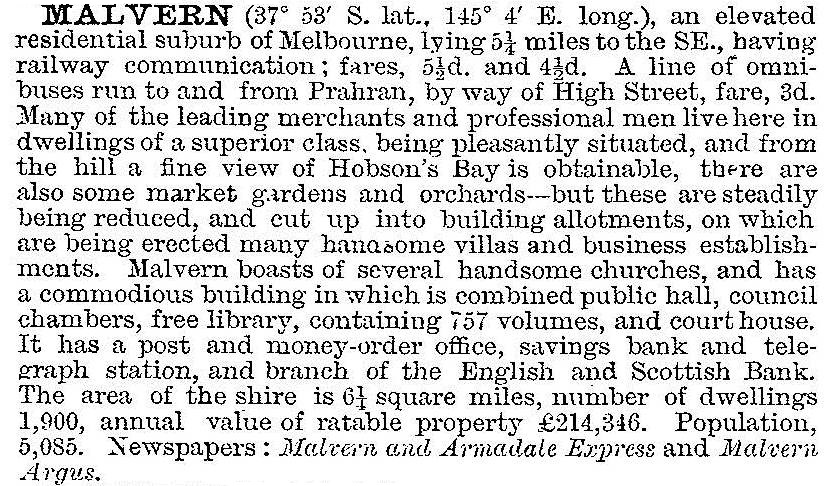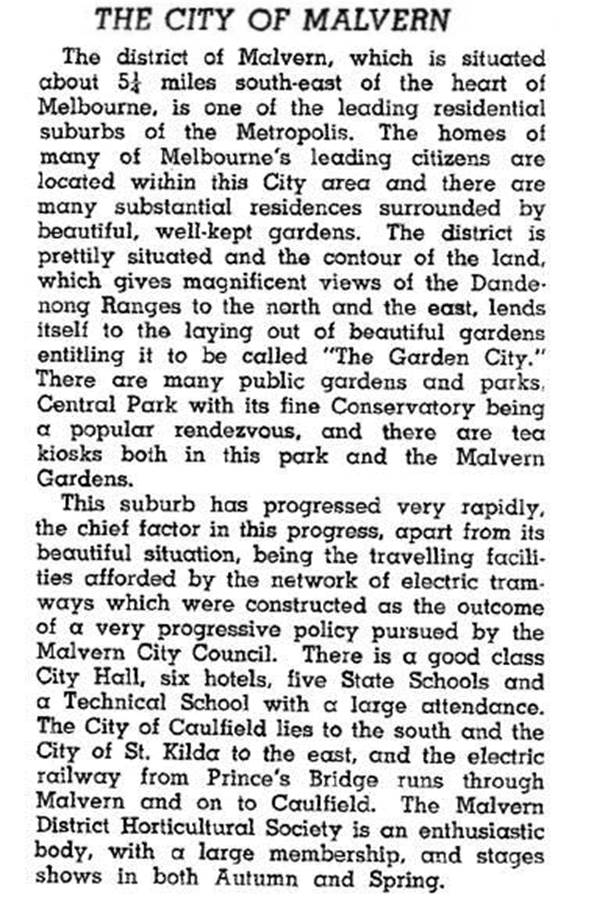Malvern
Malvern, a residential suburb 8 km south-east of Melbourne, lies between Gardiners Creek on its north and Dandenong Road on its south. It extends eastwards from Glenferrie Road, Toorak, to Tooronga Road. It was also a municipality until 1994.
The first European settler in the district was John Gardiner, pastoral overlander from Yass, New South Wales, in 1835. His homestead was probably in the vicinity of the Kooyong railway station, near the Kooyong Koot or Gardiners Creek. One authority places the homestead at the corner of Elizabeth Street and Toorak Road (Malvern) whilst there is a memorial outside Scotch College, Glenferrie Road (Hawthorn) north of the creek. Gardiner's name was given to Gardiners Creek Road (now Toorak Road), the creek, to a locality and railway station to the east, and to the original shire which was renamed Malvern in 1878.
Malvern Hill Estate
The first Government land sales were held in 1854, within the triangular area bounded by Kooyong Road, Gardiners Creek and Wattletree Road. A hamlet formed in the vicinity of Malvern and Glenferrie Roads, where a hotel was opened. Another hotel opened in 1855 in Wattletree Road to catch traffic between Melbourne and Gippsland. It is now a residence, and is on the Victorian Heritage Register. In 1856 the Gardiners Road District was formed, extending southwards to Dandenong Road.
In 1854 the Anglican church began services and opened a primary school. The bluestone St Georges Church of England (near the future town hall) was opened in 1869, and the school continued until replaced in 1875 by the State school in Spring Road (east of the town hall) in 1875.
The name Malvern arose from the Malvern Hill Estate, a number of private lots sold by Charles Skinner, barrister, in 1856. Skinner's forebears lived at Ledbury, near Malvern Hill, Herefordshire. His sale included a village named Ledbury at the north-west corner of Malvern and Glenferrie Roads, where he built the Malvern Hill Hotel. The hotel name overtook the village name as the title for the area.
Suburb
By the 1880s the district had become a site for fine residences on generous allotments, agricultural and pastoral holdings, brick and tile works, slaughter houses and night soil disposal problems. The shire hall and court house were built at the corner of High Street and Glenferrie Road in 1886, six years after the railway station was opened at the southern end of Glenferrie Road. In 1890 the northern side of the shire gained a railway from Burnley to Darling, following the southern side of Gardiners Creek. In 1893 the Australian handbook described Malvern:

Malvern gained some notable residences. Foremost was Stonnington, Glenferrie Road (1890). It was the State Government House, 1901-32, and has become a campus of Deakin University. Not far behind was Valentines, built in 1891-92 for John Davies, unsuccessful speculator. It became Malvern Grammar School (1923) and later Caulfield Grammar's junior campus. It is near Sacre Coeur girls' school (1888) accommodated in Brynmawr (1859), and Korowa Anglican girls' secondary school (1890). These three schools are in the part of the former Malvern municipality known as Glen Iris.
Gardiner Road District became Gardiner Shire in 1871 and Malvern Shire in 1876. Its area was 6 sq miles.
Local government
Malvern underwent rapid urbanisation from the turn of the century, becoming a borough in 1901, a town a few months later and a city on 30 May 1911. The district lacked trams, however, until the Prahran and Malvern Tramways Trust was formed in 1908 and opened tramlines along High Street (1910-14), Malvern Road (1915), Glenferrie Road (1910-13) and Wattletree Road (1910-12). All lines were run on electricity. The Australian blue book 1946 described Malvern as a mature municipality:

Modern suburb
The suburb of Malvern, as distinct from the municipality, runs north-south between Glenferrie Road and Tooronga Roads. It has the strong Glenferrie Road shopping strip and a smaller one in Malvern Road. In addition to the civic buildings there are the Spring Road primary school (1875) and another at the southern end in Tooronga Road (1884) next to the girls' high school (1946-93). De La Salle boys' college (1912) and St Josephs Catholic primary school are near the town hall. The present town hall buildings were built in 1886 with interior remodelling in 1927. They are a frequent venue for art auctions and antique fairs. Malvern was described in the 1903 Australian handbook:

Malvern has public gardens and an oval near the town hall and public gardens in Spring Road. Other public reserves are further afield, mostly along the Gardiners Creek valley.
Malvern’s heritage-listed buildings include: Town hall (1886), Stonnington (1890), Presbyterian church, Wattletree Road (1906), Railway station (1912) and Former ES and A bank, opposite Town hall (1959).
At the 2011 census, Malvern residents’ median incomes were 64% above the Victorian median.
The Malvern municipality contained the eastern part of Toorak, the western part of Glen Iris and part of Chadstone. All of its suburbs and localities are listed below under further reading. On 22 June 1994, Malvern city and most of Prahran city were united to form Stonnington city.
Malvern township and Malvern municipality had census populations of:
| census date | population | ||
|---|---|---|---|
|
Malvern township |
Malvern municipality |
Malvern suburb |
|
| 1871 | 449 | 1148 | |
| 1881 | 1012 | 1797 | |
| 1891 | 5085 | 8136 | |
| 1901 | 10,619 | ||
| 1911 | 15,969 | ||
| 1921 | 32,306 | ||
| 1933 | 43,244 | ||
| 1947 | 49,114 | ||
| 1954 | 46,910 | ||
| 1966 | 50,051 | ||
| 1976 | 47,800 | ||
| 1981 | 45,000 | ||
| 1991 | 41,340 | ||
| 2001 | 9414 | ||
| 2006 | 9422 | ||
| 2011 | 9504 | ||
Further Reading
J.B. Cooper, The history of Malvern from its first settlement to a city, The Specialty Press, 1935
Nigel Lewis Richard Aitken Pty Ltd, City of Malvern heritage study, 1992
Lynne Strahan, Private and public memory: a history of the City of Malvern, Hargren, 1989
Stonnington thematic environmental history, Prahran, 2006
Ian A. Brady, Prahan and Malvern Tramways Trust: Melbourne's foremost municipal tramway, Sydney, 2011
Armadale, Chadstone, Gardiner, Glen Iris, Holmesglen, Kooyong, Malvern East, Toorak and Tooronga entries


